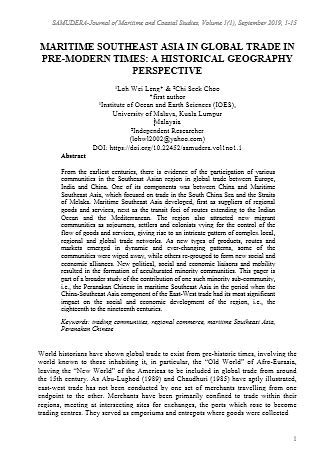MARITIME SOUTHEAST ASIA IN GLOBAL TRADE IN PRE-MODERN TIMES: A HISTORICAL GEOGRAPHY PERSPECTIVE
Main Article Content
Abstract
From the earliest centuries, there is evidence of the participation of various communities in the Southeast Asian region in global trade between Europe, India and China. One of its components was between China and Maritime Southeast Asia, which focused on trade in the South China Sea and the Straits of Melaka. Maritime Southeast Asia developed, first as suppliers of regional goods and services, next as the transit foci of routes extending to the Indian Ocean and the Mediterranean. The region also attracted new migrant communities as sojourners, settlers and colonists vying for the control of the flow of goods and services, giving rise to an intricate pattern of complex local, regional and global trade networks. As new types of products, routes and markets emerged in dynamic and ever-changing patterns, some of the communities were wiped away, while others re-grouped to form new social and economic alliances. New political, social and economic liaisons and mobility resulted in the formation of acculturated minority communities. This paper is part of a broader study of the contribution of one such minority sub-community, i.e., the Peranakan Chinese in maritime Southeast Asia in the period when the China-Southeast Asia component of the East-West trade had its most significant impact on the social and economic development of the region, i.e., the eighteenth to the nineteenth centuries.
Keywords: trading communities, regional commerce, maritime Southeast Asia, Peranakan Chinese
Downloads
Article Details
References
1350, New York: Oxford University Press.
Jamil, A., Darmawaty, Y., & Wachyuni, S. (2004). Atlas Sejarah Indonesia dan Dunia
(Indonesian and World Historical Atlas) Jakarta (accessed:
http://ms.wikipedia.org/wiki/Fail:Southeast_Asia_trade_route_map_XIIcentury.
jpg, 30/1/2012)
Beaujard, P. (2005). “The Indian Ocean in Eurasian and African World Systems Before
the 16th Century”, Journal of World History, 16, 4: 411-466.
Beaujard, P. (2010). “From Three Possible Iron-Age World-Systems to a Single AfroEurasian World-System”, Journal of World History, 21, 1: 1-43.
Bentley, J.H., & Ziegler, H.F. (2005). Traditions and Encounters: A Global Perspective
on the Past, New York: McGraw-Hill, 3rd Edition.
Chaudhuri, K. N. (1985). Trade and Civilisation in the Indian Ocean: An Economic
History from the Rise of Islam to 1750, Cambridge: Cambridge University
Press.
Chang, P. (1991). “The First Chinese Diaspora in Southeast Asia in the Fifteenth
Century”. In Roderich Ptak and Rothermund Dietmar, (Eds.), Emporia,
Commodities and Entrepreneurship in Asian Maritime Trade C. 1400-1750,
Stuttgart: Steiner Verlag: 13-28.
Clark, H. R. (2006). “Maritime Diasporas in Asia before Da Gama: An Introductory
Commentary”, Journal of the Economic and Social History of the Orient, 49, 4:
385-394.
Curtin, P. D. (1984) Cross Cultural Trade in World History, Cambridge: Cambridge
University Press.
Frank, A.G. (1992), “The Centrality of Central Asia”, Bulletin of Concerned Asian
Scholars, 24, 2: 50-74.
Frank, A.G. (1999). Reorient: Global Economy in the Asian Age, Berkeley: University
of California Press.
Frank A.G. & Gills, B.K., eds. (1994). The World System: Five Hundred Years or Five
Thousand? London: Routledge.
Heng, D. (2009). Sino-Malay Trade and Diplomacy from the Tenth through the
Fourteenth Century, Athens: Ohio University Press.
Hill, J.E. (2009). Through the Jade Gate to Rome: A Study of Silk Routes During the
Later Han Dynasty First and Second Centuries AD; An Annotated Translation
of the Chronicles of the Western Regions from the Hou Hanshu, Appendix B:
The Story of Sea Silk, 468-476, Book Surge.
Hourani, G. F. ( 1963). Arab Seafaring in the Indian Ocean in Ancient and Early
Medieval Times, Beirut: Khayats Oriental Reprints No. 3.
Hirth, F., & Rockhill, W.W. (translators) (1966). Chau Ju-Kua: His work on the
Chinese and Arab Trade in the Twelfth and Thirteenth Centuries, entitled Chufan-chi, New York: Paragon Book Reprint Corp.
Lawton, J. (2004). Silk, Scents and Spices, Tracing the World’s Great Trade Routes:
The Silk Road, the Spice Route, the Incense Trail, Paris: UNESCO and Belitha
Press.
Legge, J. (translator) (1886). A Record of Buddhistic Kingdoms: Being An Account of
the Chinese Monk Fa-hsien of His Travels, University of Adelaide Library,
ebooks@Adelaide (Accessed 1/8/2010).
Lockhard., C. (2010). "The Sea Common to All: Maritime Frontiers, Port Cities, and
Chinese Traders in the Southeast Asian Age of Commerce ca. 1400-1750",
Journal of World History, 21, 2: 219-247.
Manguin, P. (1980). “The Southeast Asian Ship”, Journal of Southeast Asian Studies,
11, 2: 266-276.
Miller, J. I. (1969). The spice trade of the Roman Empire 29 B.C. to A.D. 641. Oxford:
Clarendon Press.
Missen, J.G. (1972). Viewpoint of Indonesia, A Geographical Study (Asia Society
Education, @sites.asiasociety.org/education/islam_in.../17MalaccaTrade .pdf,
accessed, 1/12/2012)
Munoz, P.M. (2006). Early Kingdoms of the Indonesian Archipelago and the Malay
Peninsula, Singapore: Editions Didier Millet.
Reid, A. (2000). Charting the Shape of Early Modern Southeast Asia, Chiang Mai:
Silkworm Books.
Sen, T. (2006). “The Formation of Chinese Maritime Networks to Southern Asia, 1200-
1450”, Journal of the Economic and Social History of the Orient, 49, 4: 421-
453.
Shen, F. W. (1996). Cultural Flow Between China and the Outside World, Beijing:
Foreign Language Press.
Wallerstein, I. (1974). The Modern World-System: Capitalist Agriculture and the
Origins of the European World-Economy in the Sixteenth Century, New York:
Academic Press
